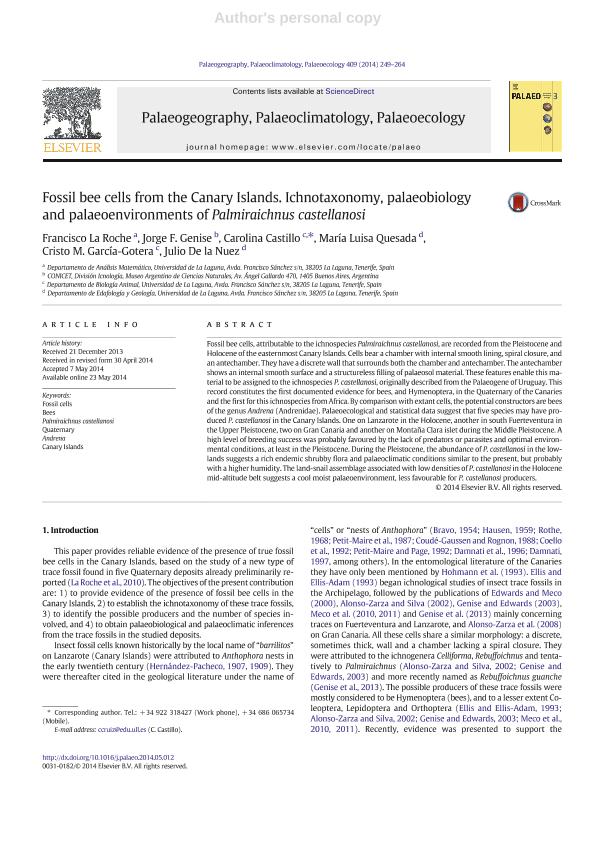Mostrar el registro sencillo del ítem
dc.contributor.author
La Roche, Francisco
dc.contributor.author
Genise, Jorge Fernando

dc.contributor.author
Castillo, Carolina
dc.contributor.author
Quesada, María Luisa
dc.contributor.author
García Gotera, Cristo M.
dc.contributor.author
De la Nuez, Julio
dc.date.available
2019-09-26T15:38:52Z
dc.date.issued
2014-09
dc.identifier.citation
La Roche, Francisco; Genise, Jorge Fernando; Castillo, Carolina; Quesada, María Luisa; García Gotera, Cristo M.; et al.; Fossil bee cells from the Canary Islands. Ichnotaxonomy, palaeobiology and palaeoenvironments of Palmiraichnus castellanosi; Elsevier Science; Palaeogeography, Palaeoclimatology, Palaeoecology; 409; 9-2014; 249-264
dc.identifier.issn
0031-0182
dc.identifier.uri
http://hdl.handle.net/11336/84525
dc.description.abstract
Fossil bee cells, attributable to the ichnospecies Palmiraichnus castellanosi, are recorded from the Pleistocene and Holocene of the easternmost Canary Islands. Cells bear a chamber with internal smooth lining, spiral closure, and an antechamber. They have a discrete wall that surrounds both the chamber and antechamber. The antechamber shows an internal smooth surface and a structureless filling of palaeosol material. These features enable this material to be assigned to the ichnospecies P. castellanosi, originally described from the Palaeogene of Uruguay. This record constitutes the first documented evidence for bees, and Hymenoptera, in the Quaternary of the Canaries and the first for this ichnospecies from Africa. By comparison with extant cells, the potential constructors are bees of the genus Andrena (Andrenidae). Palaeoecological and statistical data suggest that five species may have produced P. castellanosi in the Canary Islands. One on Lanzarote in the Holocene, another in south Fuerteventura in the Upper Pleistocene, two on Gran Canaria and another on Montan&tild;a Clara islet during the Middle Pleistocene. A high level of breeding success was probably favoured by the lack of predators or parasites and optimal environmental conditions, at least in the Pleistocene. During the Pleistocene, the abundance of P. castellanosi in the lowlands suggests a rich endemic shrubby flora and palaeoclimatic conditions similar to the present, but probably with a higher humidity. The land-snail assemblage associated with low densities of P. castellanosi in the Holocene mid-altitude belt suggests a cool moist palaeoenvironment, less favourable for P. castellanosi producers.
dc.format
application/pdf
dc.language.iso
eng
dc.publisher
Elsevier Science

dc.rights
info:eu-repo/semantics/openAccess
dc.rights.uri
https://creativecommons.org/licenses/by-nc-nd/2.5/ar/
dc.subject
ANDRENA
dc.subject
BEES
dc.subject
CANARY ISLANDS
dc.subject
FOSSIL CELLS
dc.subject
PALMIRAICHNUS CASTELLANOSI
dc.subject
QUATERNARY
dc.subject.classification
Otras Ciencias Naturales y Exactas

dc.subject.classification
Otras Ciencias Naturales y Exactas

dc.subject.classification
CIENCIAS NATURALES Y EXACTAS

dc.title
Fossil bee cells from the Canary Islands. Ichnotaxonomy, palaeobiology and palaeoenvironments of Palmiraichnus castellanosi
dc.type
info:eu-repo/semantics/article
dc.type
info:ar-repo/semantics/artículo
dc.type
info:eu-repo/semantics/publishedVersion
dc.date.updated
2019-09-24T12:52:32Z
dc.journal.volume
409
dc.journal.pagination
249-264
dc.journal.pais
Países Bajos

dc.journal.ciudad
Amsterdam
dc.description.fil
Fil: La Roche, Francisco. Universidad de La Laguna; España
dc.description.fil
Fil: Genise, Jorge Fernando. Consejo Nacional de Investigaciones Científicas y Técnicas. Oficina de Coordinación Administrativa Parque Centenario. Museo Argentino de Ciencias Naturales “Bernardino Rivadavia”; Argentina
dc.description.fil
Fil: Castillo, Carolina. Universidad de La Laguna; España
dc.description.fil
Fil: Quesada, María Luisa. Universidad de La Laguna; España
dc.description.fil
Fil: García Gotera, Cristo M.. Universidad de La Laguna; España
dc.description.fil
Fil: De la Nuez, Julio. Universidad de La Laguna; España
dc.journal.title
Palaeogeography, Palaeoclimatology, Palaeoecology

dc.relation.alternativeid
info:eu-repo/semantics/altIdentifier/doi/http://dx.doi.org/10.1016/j.palaeo.2014.05.012
dc.relation.alternativeid
info:eu-repo/semantics/altIdentifier/url/https://www.sciencedirect.com/science/article/pii/S0031018214002454
Archivos asociados
